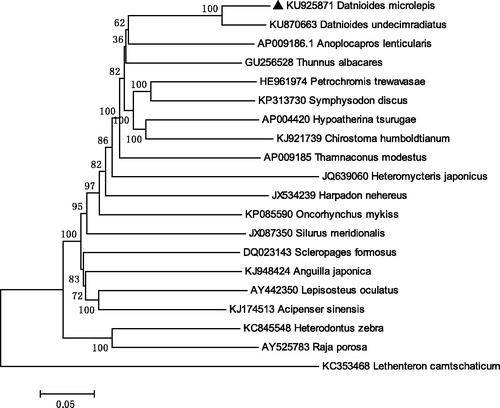Abstract
In this study, the complete mitogenome sequence of the Indonesian tiger fish Datnioides microlepis (Bleeker 1854) (Perciformes: Datnioididae) has been sequencedby next-generation sequencing method. The assembled mitogenome consisting of 16,439 bp, includes 13 protein coding genes, 22 transfer RNAs and 2 ribosomal RNAs genes. The overall base composition of Indonesian tiger fish is 27.36% for A, 30.89% for C, 17.00% for G, 24.75% for T and show 91% identities to Mekong tiger fish Datnioides undecimradiatus (GenBank: KU870663). The complete mitogenome of the Indonesian tiger fish, provides essential and important DNA molecular data for further phylogeography and evolutionary analysis for Datnioididae.
The Indonesian tiger fish Datnioides microlepis (Bleeker 1854) occurs in Chao Phraya basin, Mekong basin of mainland Southeast Asia, Kapuas basin in western Borneo and Musi basin in Sumatra (Roberts & Kottelat Citation1994). It inhabits freshwater rivers, lakes and reservoirs, frequenting areas with a lot of submerged branches, such as flooded forests (Rainboth Citation1996). Adult fish feed on small shrimps, fish fry, crabs, worms and insect larva and small fishes while young individuals take zooplankton (Rainboth Citation1996).
Samples of the Indonesian tiger fish were live imported from Indonesia, and the muscle was preserved in pure alcohol. The specimens were stored in Fish Specimens Museum in Shanghai Ocean University, the accession number is SHOU20150062002. Then, their genomic DNA was extracted from muscle by using Genomic DNA Purification Kit (GeneMark, Taichung, Taiwan). The methods for genomic DNA extraction, library construction and next generation sequencing were followed by previous publication (Shen et al. Citation2014). The raw next generation sequencing reads were de novo assembled by commercial software (Geneious V8, Auckland, New Zealand) to produce a single, circular form of complete mitogenome with about an average 338.4× coverage (13,496 out of 9,637,558, 0.0014%). The complete mitochondrial genome of the Indonesian tiger fish was 16,439 bp in size (GenBank: KU925871), includes13 protein coding genes, 22 transfer RNAs and 2 ribosomal RNAs genes. The overall base composition of the Indonesian tiger fish is 27.36% for A, 30.89% for C, 17.00% for G, 24.75% for T and show 91% identities to Mekong tiger fish Datnioides undecimradiatus (GenBank: KU870663) ().
Figure 1. Neighbour-joining (NJ) tree of 20 species complete mitochondrial genomesequence. The phylogenetic relationships of Indonesian tiger fish show 91% identities to Mekong tiger fish, Datnioides undecimradiatus.

The protein coding and tRNA genes of the Indonesian tigerfish mitogenome were predicted by using DOGMA (Wyman et al. Citation2004), ARWEN (Laslett & Canback Citation2008) and Mito Annotator (Iwasaki et al. Citation2013) tools. Some ambiguous annotation sites are manual inspected. All protein coding genes were encoded on H-strand with exception of protein-coding genes of ND6. All tRNA genes were encoded on H-strand with exception of tRNA-Glu, tRNA-Pro, tRNA-Gln, tRNA-Ala, tRNA-Asn, tRNA-Cys, tRNA-Tyr and tRNA-Ser(UGA). All the 13 mitochondrial protein-coding genes share the start codon ATG, except for COI (GTG start codon) and ATP6 (CTG start codon). The stop codon, TAA, is present in ND1, COI, COI, ATP8, ND4L and ND6; TAG, is present in ND5; and in complete stop codon “TA–” is found in ND2, CO2 and ATP6, and “T––” is found in ND3, ND4 and Cytb.
The longest one is ND5 gene (1839 bp) in all protein-coding genes, whereas the shortest is ATP8 gene (168 bp). The 2 ribosomal RNA genes, 12S rRNA gene (952 bp) and 16S rRNA gene (1704 bp) are located between tRNA-Phe and tRNA-Leu and separated by tRNA-Val. We expect that the present result would elucidate the further phylogenetic approach among different species of Datnioididae.
To validate the phylogenetic position of D. microlepis, we used MEGA6 software (Tamura et al. Citation2013) to construct a neighbour-joining (NJ) (with 1000 bootstrap replicates) containing complete mitogenomes of 20 species (). In conclusion, the complete mitogenome of D. microlepis provides essential and important DNA molecular data for phylogenetic and evolutionary analysis for Datnioididae.
Disclosure statement
The authors report no conflict of interest. The authors alone are responsible for the content and writing of the article.
Funding information
This work was supported by a grant from Shanghai Collaborative Innovation Center for Aquatic Animal Genetics and Breeding (ZF1206).
References
- Iwasaki W, Fukunaga T, Isagozawa R, Yamada K, Maeda Y, Satoh TP, Sado T, Mabuchi K, Takeshima H, Miya M, Nishida M. 2013. MitoFish and MitoAnnotator: a mitochondrial genome database of fish with an accurate and automatic annotation pipeline. Mol Biol Evol. 30:2531–2540.
- Laslett D, Canback B. 2008. ARWEN: a program to detect tRNA genes in metazoan mitochondrial nucleotide sequences. Bioinformatics. 24:172–175.
- Rainboth WJ. 1996. Fishes of the Cambodian Mekong. FAO species identification field guide for fishery purposes. Rome: FAO.
- Roberts TR, Kottelat M. 1994. The Indo-Pacific tigerperches, with a new species from the Mekong basin (Pisces: Coiidae). Ichthyol Explor Freshwat. 5:257–266.
- Shen KN, Yen TC, Chen CH, Li HY, Chen PL, Hsiao CD. 2014. Next generation sequencing yields the complete mitochondrial genome of the flathead mullet, Mugil cephalus cryptic species NWP2 (Teleostei: Mugilidae). Mitochondrial DNA. [Epub ahead of print]. doi:10.3109/19401736.2014.963799.
- Wyman SK, Jansen RK, Boore JL. 2004. Automatic annotation of organellar genomes with DOGMA. Bioinformatics. 20:3252–3255.
- Tamura K, Stecher G, Peterson D, Filipski A, Kumar S. 2013. MEGA6: molecular evolutionary genetics analysis version 6.0. Mol Biol Evol. 30:2725–2729.
